Jovian Periodicities (~10 h, ~40, 20, 15 min) at ACE, Upstream from the Earth’s Bow Shock, on 25–27 November 2003
Abstract
1. Introduction
1.1. Energetic Particles in the Heliosphere
1.2. Near Earth’s Bow Shock Ion Events
1.3. Ion Events Far Upstream (~200 Re) from the Earth’s Bow Shock
1.4. Jovian Energetic Particles Far (~200 Re) Upstream from the Earth’s Bow Shock
2. Instrumentation and Data
2.1. The ACE Mission and Instrumentation
2.2. The EPAM and MAG Instrument
2.3. GEOTAIL Mission. Proton and Magnetic Field Instruments
2.4. The Ulysses Mission and Instrumentation
3. Observations
3.1. QP-10 h Ion Events Far Upstream from the Bow Shock: ACE Observations
3.2. ACE—Geotail Observations Compared
3.2.1. ACE Ion Event #5
3.2.2. ACE Ion Event #3
3.3. Jovian Electron/Ion/Magnetic Field Periodicities (10/5, 40/15–20 min) Near Earth
3.4. Jupiter-Earth Magnetic Connection and Jovian Emissions at Ulysses
4. Summary of Observations and Discussion
4.1. The Most Important Observational Findings on 25–27 November (329–331), 2003
- (1)
- (2)
- (3)
- The QP-40 min and QP-15/20 min periodicities of the IMF and the electron spectrum were superimposed on QP-10/5 h variations as within and upstream from Jupiter.
- (4)
- QP-10/5 h distinct low-energy (<0.05 MeV) ion (proton) bursts were observed by ACE with unusually high intensities and soft spectra (p/b ≅ 1.5 × 102 at 61–77 keV and spectral γ ≅ 4.2 between ~55–250 keV (Figure 8). QP-10/5 h variations were also found in high energy (~0.06–0.50 MeV) heavy (Z > 5) ion flux (Figure 3).
- (5)
- The QP-10/5 h EIBs were characterized by field-aligned ion streaming in the anti-sunward direction during the main phase of the events, and cross-field intensity gradients at the onset and the decay phase of the events suggesting a QP-10/5 h entrance of ACE in a (pre-existing) quasi-permanent large-scale sheet of particles.
- (6)
- The comparison of ion fluxes and spectra upstream from the down bow shock (Geotail) and at LPL1 (ACE) were found to be inconsistent with the major predictions of the first-order Fermi acceleration and the SDA mechanism as well as with leakage from the magnetosphere (ion data were compared with the angle θΒn, between the IMF and the normal to the bow shock vector n, the connection time of the field line with the bow shock tC, the velocity dispersion at the onset of events, PADs, indexes of geomagnetic activity etc).
- (7)
- The QP-10/5 h, QP-40 min, QP-20 and QP-15 min periodicities in particle and magnetic field data at ACE were observed during a period of a highly disturbed Jovian magnetosphere, as inferred from distinct QP-10 h bKOM radio emissions observed by Ulysses during its distant encounter with Jupiter (Figure 13b).
- (8)
- Simulation results of the IMF configuration suggest that there was magnetic field conjunction of Earth with Jupiter (Figure 14).
4.2. Upstream Energetic Electrons and Magnetic Waves at LPL1
4.3. QP-10/5 h Upstream Energetic Ion Bursts at LPL1
4.3.1. Generating Physical Mechanism
- (a)
- The series of QP-10 EIBs, with high intensities, were observed under conditions of a quiet magnetosphere (as inferred from the geomagnetic indexes and the absence of particle injections in the inner magnetosphere occurring during magnetic storms; Figure 3g and Figure 7c,d. Therefore, the detection of QP-10 h high-intensity EIBs on 25–27 November 2003 at LPL1 is inconsistent with the “leakage” model of magnetospheric ions [7,8,11,15,27].
- (b)
- The comparison of simultaneously obtained Geotail and ACE measurements suggests the presence of a sheet of energetic particles with almost the same high ion intensity and soft spectral slope (γ ≅ 4.2; dj/dE~E−γ) in the whole region from the bow shock (Geotail) to the LPL1 (ACE). Such an upstream ion distribution is inconsistent with the intensity gradient in the direction from the upstream region toward the Earth’s bow shock, which is a well-confirmed feature of upstream energetic ions escaping from the bow shock front produced by either shock acceleration or by leakage from the magnetosphere) [4,7,14,20,31]. Moreover, the high ion intensity in some cases was found to be higher ACE than at Geotail (Figure 8). This finding is inconsistent with all previous reports on the spatial distribution of upstream energetic ions [20,27,36].
- (c)
- During the main phase of the EIBs, the PADs show a field-aligned ion anisotropy suggesting a field-aligned streaming directed outward from the Sun. Such streaming, along with the above findings (a) and (b), strongly recommend an extra-terrestrial origin of the EIBs on November 27 (331), 2003.
- (d)
- SDA of the solar ambient >50 keV proton population, occurring at quasi-perpendicular (θBn > 45°) sites of the bow shock, show peak-to-background flux ratio ranging in values between p/b ≅ 2–5 [12,68]. Contrarily, the QP-10 h EIBs show a significantly high peak-to-background flux ratio (i.e., p/b ≅ 102) both close (Geotail) and far (ACE) from the bow shock. Therefore, the origin of EIBs on 25–27 November 2003 is inconsistent with the SDA of the solar ambient ion population.
- (e)
- First-order Fermi acceleration as applied at Earth’s bow shock is effective: (A) at quasi-parallel (θBn < 45°) bow shock structures, (B) under high values of the connection time tC and (C) in the presence of distinct inverse velocity dispersion at the onset phase of the upstream ion events (see Section 1, “Introduction). Detailed elaboration of representative Geotail data obtained close to the bow shock (ACE EIB #5) revealed that they were in contrast to the significant predictions (A–C) of the first-order Fermi acceleration mechanism [17,18,61].
- (f)
- The QP-10/5 h EIBs were observed during the presence of a fluctuating IMF (QP-40 min and QP-15–20 min periodicities superposed on ~5/10 h periodic variation), which suggests a variety of bow shock conditions during each event and throughout the whole period 25–27 November 2003.
- (g)
- No known physical process in the Earth’s magnetosphere or at the bow shock could produce quasi-steady strong streaming of energetic ions, which could be observed at LPL1 due to its ~10 h directional variation. Therefore, the QP-10 h appearance of EIBs on 25–27 November 2003 raises severe problems attributing a terrestrial (magnetospheric or bow shock) physical process as responsible for the QP-10/5 h EIBs at LPLl.
4.3.2. On the Origin of the Ion Population Giving Rise to the QP-10/5 h EIBs at LPL1
5. Conclusions
Author Contributions
Funding
Data Availability Statement
Acknowledgments
Conflicts of Interest
Appendix A
References
- Marhavilas, P.K.; Sarris, E.T.; Anagnostopoulos, G.C. Observations of shock acceleration signatures by Ulysses: The 04:08:16, day 147, 1991 UT shock. J. Atmos. Sol. Terr. Phys. 2002, 64, 527–533. [Google Scholar] [CrossRef]
- Desai, M.; Giacalone, J. Large gradual solar energetic particle events. Living Rev. Sol. Phys. 2016, 13, 3. [Google Scholar] [CrossRef] [PubMed]
- Anagnostopoulos, G.C.; Tenentes, V.; Vassiliadis, E.S. The Quasi-Perpendicular Bow Shock as a Temporal Trapping Bar-rier and Accelerator of Magnetospheric Particles. IEEE Trans. Plasma Sci. 2008, 36, 542–553. [Google Scholar] [CrossRef]
- Keika, K.; Nosé, M.; Christon, S.P.; McEntire, R.W. Acceleration sites of energetic ions upstream of the Earth’s bow shock and in the magnetosheath: Statistical study on charge states of heavy ions. J. Geophys. Res. 2004, 109, A11104. [Google Scholar] [CrossRef]
- Christon, S.P.; Desai, M.I.; Eastman, T.E.; Gloeckler, G.; Kokubun, S.; Lui, A.T.Y.; McEntire, R.W.; Roelof, E.C.; Williams, D.J. Low-Charge-State Heavy Ions Upstream of Earth’s Bow Shock and Sunward Flux of Ionospheric O +1, N +1, and 0 +2 Ions: Geotail Observations. Geophys. Res. Lett. 2000, 27, 2433–2436. [Google Scholar] [CrossRef]
- Anagnostopoulos, G.C.; Paschalidis, N.; Littas, A.N. Energy time dispersion of a new class of magnetospheric ion events observed near the Earth’s bow shock. Ann. Geophysicae 2000, 18, 2–41. [Google Scholar] [CrossRef]
- Anagnostopoulos, G.C.; Kaliabetsos, G.; Argyropoulos, G.; Sarris, E.T. High energy ions and electrons upstream from the Earth’s bow shock and their dependence on geomagnetic conditions: Statistical results between years 1982–1988. Geophys. Res. Lett. 1999, 26, 2151–2154. [Google Scholar] [CrossRef]
- Anagnostopoulos, G.C.; Rigas, A.G.; Sarris, E.T.; Krimigis, S.M. Characteristics of upstream energetic (E ≥ 50 keV) ion events during intense geomagnetic activity. J. Geophys. Res. 1998, 103, 9521–9533. [Google Scholar] [CrossRef]
- Anagnostopoulos, G.C.; Sarris, E.T.; Krimigis, S.M. On the Origin of the Forward Velocity Dispersion of Ion Events Observed Near the Earth’s and Jupiter’s Bow Shock. Adv. Space Res. 1995, 16, 149–152. [Google Scholar] [CrossRef]
- Kudela, K.; Sibeck, D.G.; Belian, R.D.; Fischer, S.; Lutsenko, V. Possible leakage of energetic particles from the magnetosphere into the upstream region on 7 June 1985. J. Geophys. Res. 1992, 95, 20825. [Google Scholar] [CrossRef]
- Sibeck, D.G.; McEntire, R.W.; Krimigis, S.M.; Baker, D.N. The magnetosphere as a sufficient source for upsream ions on 1 November 1984. J. Geophys. Res. 1988, 99, 14328. [Google Scholar] [CrossRef]
- Anagnostopoulos, G.C.; Sarris, E.T.; Krimigis, S.M. Observational Test of Shock Drift and Fermi Acceleration on a Seed Particle Population Upstream of Earth’s Bow Shock. J. Geophys. Res. 1988, 93, 5541–5546. [Google Scholar] [CrossRef]
- Anagnostopoulos, G.C.; Sarris, E.T.; Krimigis, S.M. Magnetospheric origin of energetic (E ≥ 50 KeV) ions upstream of the bow shock: The 31 October 1977 event. J. Geophys. Res. 1986, 91, 3020–3028. [Google Scholar] [CrossRef]
- Sarris, E.T.; Krimigis, S.M.; Bostrom, C.O.; Armstrong, T.P. Simultaneous multispacecraft observations of ener-getic proton bursts inside and outside the magnetosphere. J. Geophys. Res. 1978, 83, 4289. [Google Scholar] [CrossRef]
- Anagnostopoulos, G.C.; Efthymiadis, D.; Sarris, E.T.; Krimigis, S.M. Evidence and features of magnetospheric particle leakage on days 30–36, 1995: Wind, Geotail, and IMP 8 observations compared. J. Geophys. Res. Space Phys. 2005, 110, A10203. [Google Scholar] [CrossRef]
- Kronberg, E.A.; Bučík, R.; Haaland, S.; Klecker, B.; Keika, K.; Desai, M.I.; Daly, P.W.; Yamauchi, M.; Gómez-Herrero, R.; Lui, A.T.Y. On the origin of the energetic ion events measured upstream of the Earth’s bow shock by STEREO, Clus-ter, and Geotail. J. Geophys. Res. 2011, 116, A02210. [Google Scholar] [CrossRef]
- Sarris, E.T.; Van Allen, J.A. Effects of interplanetary shock waves on energetic charged particles. J. Geophys. Res. 1974, 79, 4157. [Google Scholar] [CrossRef]
- Decker, R.B. Formation of shock-spike events at quasiperpendicular shocks. J. Geophys. Res. 1983, 88, 9959. [Google Scholar] [CrossRef]
- Scholer, M.; Ipavich, F.; Gloeckler, G.; Hovestadt, D. Conditions for acceleration of energetic ions ≳30 keV associ-ated with the Earth’s bow shock. J. Geophys. Res. 1980, 85, 4602–4606. [Google Scholar] [CrossRef]
- Mitchell, D.G.; Roelof, E.C. Dependence of 50-keV upstream ion events at IMP 7 and 8 upon magnetic field bow shock geometry. J. Geophys. Res. 1983, 88, 5623–5634. [Google Scholar] [CrossRef]
- Ipavich, F.M.; Galvin, A.B.; Gloeckler, G.; Scholer, M.; Hovestadt, D. A statistical survey of ions observed upstream of the Earth’s bow shock: Energy spectra, composition, and spatial variation. J. Geophys. Res. 1981, 86, 4337–4342. [Google Scholar] [CrossRef]
- Wibberenz, G.; Zoellich, F.; Fischer, H.M.; Keppler, E. Dynamics of intense upstream ion events. J. Geophys. Res. 1985, 90, 283–301. [Google Scholar] [CrossRef]
- Ellison, D.C. Comment on “Magnetospheric origin of energetic (E ≥ 50 keV) ions upstream of the bow shock: The October 31, 1977, event” by G.C. Anagnostopoulos, E.T. Sarris, and S.M. Krimigis. J. Geophys. Res. 1987, 92, 12458–12460. [Google Scholar] [CrossRef]
- Skadron, G.; Lee, M.A. Temporal development of diffuse ion events upstream of the Earth’s bow shock: The October 31, 1977, event. J. Geophys. Res. 1983, 88, 9975. [Google Scholar] [CrossRef]
- Lee, M.A. Coupled hydromagnetic wave excitation and ion acceleration upstream of the Earth’s bow shock. J. Geophys. Res. 1982, 87, 5063–5080. [Google Scholar] [CrossRef]
- Ipavich, F.M.; Scholer, M.; Gloeckler, G. Temporal development of composition, spectra, and anisotropies during upstream particle events. J. Geophys. Res. 1981, 86, 11153. [Google Scholar] [CrossRef]
- Scholer, M.; Hovestadt, D.; Ipavich, F.M.; Gloeckler, G. Upstream energetic ions and electrons: Bow shock-associated or magnetospheric origin? J. Geophys. Res. 1981, 86, 9040–9046. [Google Scholar] [CrossRef]
- Desai, M.I.; Mason, G.M.; Dwyer, J.R.; Mazur, J.E.; von Rosenvinge, T.T.; Lepping, R.P. Characteristics of energetic (30 keV/nucleon) ions observed by the Wind/STEP instrument upstream of the Earth’s bow shock. J. Geophys. Res. 2000, 105, 61–78. [Google Scholar] [CrossRef]
- Posner, A.; Sohwadron, N.A.; Zurbuchen, T.H.; Kozyra, J.U.; Liemohn, M.W.; Gloeckler, G. Association of low-charge-state theory ions up to 200 Re upstream of the Earth’s bow shock with geomagnetic disturbances. Geophys. Res. Lett. 2002, 29, 1099. [Google Scholar] [CrossRef]
- Klassen, A.; Gómez-Herrero, R.; Müller-Mellin, R.; Böttcher, S.; Heber, B.; Wimmer-Schweingruber, R.; Mason, G.M. STE-REO/SEPT observations of upstream particle events: Almost monoenergetic ion beams. Annal. Geoph. 2009, 27, 2077–2085. [Google Scholar] [CrossRef]
- Karanikola, I.; Anagnostopoulos, G.C.; Rigas, A. Characteristics of ≥290 keV magnetosheath ions. Ann. Geophys. 1999, 17, 650–658. [Google Scholar] [CrossRef]
- Paschalidis, N.P.; Sarris, E.T.; Krimigis, S.M.; McEntire, R.W.; Levine, M.D.; Daglis, I.A.; Anagnostopoulos, G.C. Energetic Ion Distributions on both sides of the Earth’s Magnetopause. J. Geophys. Res. 1994, 99, 8687–8703. [Google Scholar] [CrossRef]
- Anagnostopoulos, G.C.; Vassiliadis, E.S.; Karanikola, I. Dawn-dusk asymmetry in spatial distribution and origin of energetic ion events upstream the Earth’s bow shock. Planet. Space Sci. 2005, 53, 53–58. [Google Scholar] [CrossRef]
- Vassiliadis, E.; Anagnostopoulos, G. The onset phase of upstream energetic (>25 KEV) ion events: Interball-1/DOK-2 ob-servations. Adv. Space Res. 2003, 31, 1463–1471. [Google Scholar] [CrossRef]
- Sanderson, T.R.; Reinhard, R.; Wenzel, K.-P.; Roelof, E.C.; Smith, E.J. Observations of upstream ions and low-frequency waves on ISEE 3. J. Geophys. Res. 1983, 88, 85–95. [Google Scholar] [CrossRef]
- Maragkakis, M.G.; Anagnostopoulos, G.C.; Vassiliadis, E.S. Upstream ion events with hard energy spectra: Lessons for their origin from a comparative statistical study (ACE/Geotail). Planet. Space Sci. 2013, 85, 1–12. [Google Scholar] [CrossRef]
- Haggerty, D.K.; Desai, M.I.; Mason, G.M.; Dwyer, J.R.; Gold, R.E.; Krimigis, S.M.; Mazur, J.E.; Von Rosenvinge, T.T. Simultaneous observations of energetic (∼150 keV) protons upstream of the Earth’s bow shock at ACE and WIND. Geophys. Res. Lett. 1999, 26, 169–172. [Google Scholar] [CrossRef]
- Mason, G.M.; Dwyer, J.R.; Mazur, J.E. New properties of 3He-rich solar flares deduced from low-energy particle spectra. Astrophys. J. 2000, 545, L157–L160. [Google Scholar] [CrossRef]
- Gurnett, D.A.; Kurth, W.S.; Hospodarsky, G.B.; Persoon, A.M.; Zarka, P.; Lecacheux, A.; Bolton, S.J.; Desch, M.D.; Farrell, W.M.; Kaiser, M.L.; et al. Control of Jupiter’s radio emission and aurorae by the solar wind. Nature 2002, 415, 985–987. [Google Scholar] [CrossRef] [PubMed]
- Baron, R.L.; Owen, T.; Connerney, J.E.P.; Satoh, T.; Harrington, J. Solar Wind Control of Jupiter’s H+3Auroras. Icarus 1996, 120, 437–442. [Google Scholar] [CrossRef]
- Terasawa, T.; Maezawa, K.; Machida, S. Solar wind effect on Jupiter’s non-Io related radio emission. Nature 1978, 273, 131. [Google Scholar] [CrossRef]
- Cravens, T.E.; Ozak, N. Auroral ion precipitation and acceleration at the outer planets. In Auroral Phenomenology and Magnetospheric Processes: Earth and Other Planets; Keiling, A., Donovan, E., Bagenal, F., Karlsson, T., Eds.; AGU: Washington, DC, USA, 2012; pp. 287–294. [Google Scholar]
- Cravens, T.E.; Waite, J.H.; Gombosi, T.I.; Lugaz, N.; Gladstone, G.R.; Mauk, B.H.; MacDowall, R.J. Implications of Jovian X-ray emission for magnetosphere-ionosphere coupling. J. Geophys. Res. 2003, 108, 1465. [Google Scholar] [CrossRef]
- MacDowall, R.J.; Kaiser, M.L.; Desch, M.D.; Farrell, W.M.; Hess, R.A.; Stone, R.G. Quasi-periodic Jovian radio bursts: Obser-vations from the Ulysses Radio and Plasma Wave Experiment. Planet. Space Sci. 1993, 41, 1059. [Google Scholar] [CrossRef]
- Owens, M.J.; Horbury, T.S.; Arge, C.N. Probing the large-scale topology of the heliospheric magnetic field using Jovian elec-trons. Astrophys. J. 2010, 714, 1617–1623. [Google Scholar] [CrossRef]
- del Peral, L.; Gomez-Herrero, R.; Rodrıguez-Frıas, M.D.; Gutierrez, J.; Muller-Mellin, R.; Kunow, H. Jovian electrons in the he-liosphere: New insights from EPHIN on board SOHO. Astropart. Phys. 2003, 20, 235–245. [Google Scholar] [CrossRef]
- Moses, S.L.; Coroniti, F.V.; Kennel, C.F.; Scarf, F.L.; Greenstadt, E.W.; Kurth, W.S.; Lepping, R.P. High time resolution plasma wave and magnetic field observations of the Jovian bow shock. Geophys. Res. Lett. 1985, 12, 183–186. [Google Scholar] [CrossRef]
- Chenette, D.L. The propagation of Jovian electrons to Earth. J. Geophys. Res. 1980, 85, 2243–2256. [Google Scholar] [CrossRef]
- Krimigis, S.M.; Sarris, E.T.; Armstrong, T.P. Observations of Jovian electron events in the vicinity of Earth. Geophys. Res. Lett. 1975, 2, 561–564. [Google Scholar] [CrossRef]
- Lario, D.; Decker, R.B.; Livi, S.; Krimigis, S.M.; Roelof, E.C.; Russell, C.T.; Fry, C.D. Heliospheric energetic particle observations during the October–November 2003 events. J. Geophys. Res. 2005, 110, A09S11. [Google Scholar] [CrossRef]
- Malandraki, O.; Lario, E.D.; Lanzerotti, L.J.; Sarris, E.T.; Geranios, A.; Tsiropoula, G. October/November 2003 interplanetary coronal mass ejections: ACE/EPAM solar energetic particle observations. J. Geophys. Res. 2005, 110, 1–10. [Google Scholar] [CrossRef]
- McKibben, R.B.; Anglin, J.D.; Connell, J.J.; Dalla, S.; Heber, B.; Kunow, H.; Lopate, C.; Marsden, R.G.; Sanderson, T.R.; Zhang, M. Energetic particle observations from the Ulysses COSPIN instruments obtained during the October–November 2003 events. J. Geophys. Res. Space Phys. 2005, 110, A09S19. [Google Scholar] [CrossRef]
- Louri, I. Periodicities of Electromagnetic Measurements of Possible Extra-Terrestrial Origin. Master’s Thesis, Demokritos University of Thrace, Komotini, Greece, 2011. [Google Scholar]
- Anagnostopoulos, G.C.; Louri, I.; Marhavilas, P.; Sarris, E.T. Jovian periodicities (∼10 h, ∼40 min) on Ulysses’ Distant Jupiter Encounter observations around the Halloween CIR events. Adv. Space Res. 2009, 43, 573–581. [Google Scholar] [CrossRef]
- Anagnostopoulos, G.C.; Balogh, A.; Marhavilas, P.K.; Rigas, A.; Sarris, E.T.; Trochoutsos, P.C. Quasiperiodic behavior of ion events and wave activity upstream from Jupiter’s bow shock: Ulysses’ observations. Geophys. Res. Lett. 1998, 25, 1533. [Google Scholar] [CrossRef]
- Marhavilas, P.K. Elaboration and Analysis of Energetic particle Observations by the ULYSSES Spacecraft, in the Vicinity of Magnetohydrodynamic Surfaces. Ph.D. Thesis, Space Research Lab., Demokritos University of Thrace, Komotini, Greece, 2004. [Google Scholar]
- Marhavilas, P.K.; Anagnostopoulos, G.C.; Sarris, E.T. On a systematic spectral variation of energetic ions in the Jovian outer magnetosphere: HI-SCALE/Ulysses observations. Planet. Space Sci. 2004, 52, 5–6. [Google Scholar] [CrossRef]
- Marhavilas, P.K.; Anagnostopoulos, G.C.; Sarris, E.T. Periodic signals in Ulysses’ energetic particle events upstream and downstream from the Jovian bow shock. Planet. Space Sci. 2001, 49, 1031–1047. [Google Scholar] [CrossRef]
- Marhavilas, P.K.; Malandraki, O.E.; Anagnostopoulos, G.C. Survey of caveats in low-energy particle measurements: Ulys-ses/HI-SCALE and ACE/EPAM Instruments. Planet. Space Sci. 2015, 117, 192–206. [Google Scholar] [CrossRef]
- Gold, R.E.; Krimigis, S.M.; Hawkins, S.E., III; Haggerty, D.K.; Lohe, D.A.; Fiore, E.; Armstrong, T.P.; Holland, G.; Lanzerotti, L.J. Electron, Proton, and Alpha Monitor on the Advanced Composition Explorer Spacecraft. Space Sci. Rev. 1998, 86, 541. [Google Scholar] [CrossRef]
- Stone, E.C.; Frandsen, A.M.; Mewaldt, R.A.; Christian, E.R.; Margolies, D.; Ormes, J.F.; Snow, F. The Advanced Composition Explorer. Space Sci. Rev. 1998, 86, 1–22. [Google Scholar] [CrossRef]
- Smith, C.W.; L’Heureux, J.; Ness, N.F.; Acuna, M.H.; Burlaga, L.F.; Scheifele, J. The ACE Magnetic Fields Experiment. Space Sci. Rev. 1998, 86, 613–632. [Google Scholar] [CrossRef]
- Wenzel, K.-P.; Marsden, R.G.; Page, D.E.; Smith, E.J. The Ulysses mission, Astron. Astrophys. Suppl. Ser. 1992, 92, 207. [Google Scholar]
- Smith, E.J.; Wenzel, K.-P. Introduction to the Ulysses encounter with Jupiter. J. Geophys. Res. 1993, 98, 111. [Google Scholar] [CrossRef]
- Anagnostopoulos, G.C.; Tenentes, V.; Vassiliadis, E.S. MeV ion event observed at 0950 UT on 4 May 1998 at a quasi-perpendicular bow shock region: New observations and an alternative interpretation on its origin. J. Geophys. Res. Space Phys. 2009, 114, 1. [Google Scholar] [CrossRef]
- Anagnostopoulos, G.C. Dominant Acceleration Processes of Energetic Protons at the Earth’s Bow Shock. Phys. Scr. 1994, 1994, 142–151. [Google Scholar] [CrossRef]
- Anagnostopoulos, G.C.; Kaliabetsos, G.D. Shock drift acceleration of energetic (E ≥ 50 keV) protons and (E ≥ 37 keV/n) alpha particles at the Earth’s bow shock as a source of the magnetosheath energetic ion events. J. Geophys. Res. 1994, 99, 2335–2349. [Google Scholar] [CrossRef]
- Kudela, K.; Lutsenko, V.N.; Sarris, E.T.; Sibeck, D.G.; Slivka, M. DOK-2 ion fluxes upstream from the bow shock: Characteristics from 4 years of Interball-1 measurements. Planet. Space Sci. 2005, 53, 59–64. [Google Scholar] [CrossRef]
- Vandas, M.; Karlický, M. Electron acceleration in a wavy shock front. Astron. Astrophys. 2011, 531, A55. [Google Scholar] [CrossRef]
- Krupp, N.; Vasyliūnas, V.M.; Woch, J.; Lagg, A.; Khurana, K.K.; Kivelson, M.G.; Mauk, B.H.; Roelof, E.C.; Williams, D.J.; Krimigis, S.M.; et al. Dynamics of the Jovian Magnetosphere. In Jupiter: The Planet, Satellites and Magnetosphere; Bagenal, F., Dowling, T.E., McKinnon, W.B., Eds.; Cambridge University Press: Cambridge, UK, 2004; pp. 617–638. ISBN 0-521-81808-7. [Google Scholar]
- Vogt, A.; Heber, B.; Kopp, A.; Potgieter, M.S.; Strauss, R.D. Jovian electrons in the inner heliosphere—Proposing a new source spectrum based on 30 years of measurements. Astron. Astrophys. 2018, 613, A28. [Google Scholar] [CrossRef]
- Moses, D. Jovian electrons at 1 AU-1978-1984. Astrophys. J. 1987, 313, 471–486. [Google Scholar] [CrossRef]
- Kühl, P.; Dresing, N.; Dunzlaff, P.; Effenberger, F.; Fichtner, H.; Gieseler, J.; Gomez-Herrero, R.; Heber, B.; Klassen, A.; Kleimann, J.; et al. Spectrum of galactic and Jovian electrons. In Proceedings of the 33rd International Cosmic Ray Conference (ICRC2013), Rio de Janeiro, Brazil, 2–9 July 2013. [Google Scholar]
- Nndanganeni, R.; Potgieter, M.S. The global modulation of Galactic and Jovian electrons in the heliosphere. Astrophys. Space Sci. 2018, 363, 156. [Google Scholar] [CrossRef]
- Fisher, R.A. Test of significance in harmonic analysis. Proc. R. Soc. Lond. Ser. 1929, 125, 54–59. [Google Scholar]
- Nowroozi, A.A. Table for Fisher’s test of significance in harmonic analysis. Geophys. J. R. Astron. Soc. 1967, 12, 517–520. [Google Scholar] [CrossRef]
- Grenander, U.; Rosenblatt, M. Statistical Analysis of Stationary Time Series; John Wiley: New York, NY, USA, 1957; pp. 91–94. [Google Scholar]
- Shimshoni, M. On Fisher’s test of significance in harmonic analysis. J. R. Astron. Soc. 1971, 23, 373. [Google Scholar] [CrossRef]
- Marhavilas, P.K.; Koulouriotis, D.E.; Spartalis, S.H. Harmonic Analysis of Occupational-Accident Time-Series as a Part of the Quantified Risk Evaluation in Worksites: Application on Electric Power Industry and Construction Sector. Reliab. Eng. Syst. Saf. 2013, 112, 8–25. [Google Scholar] [CrossRef]
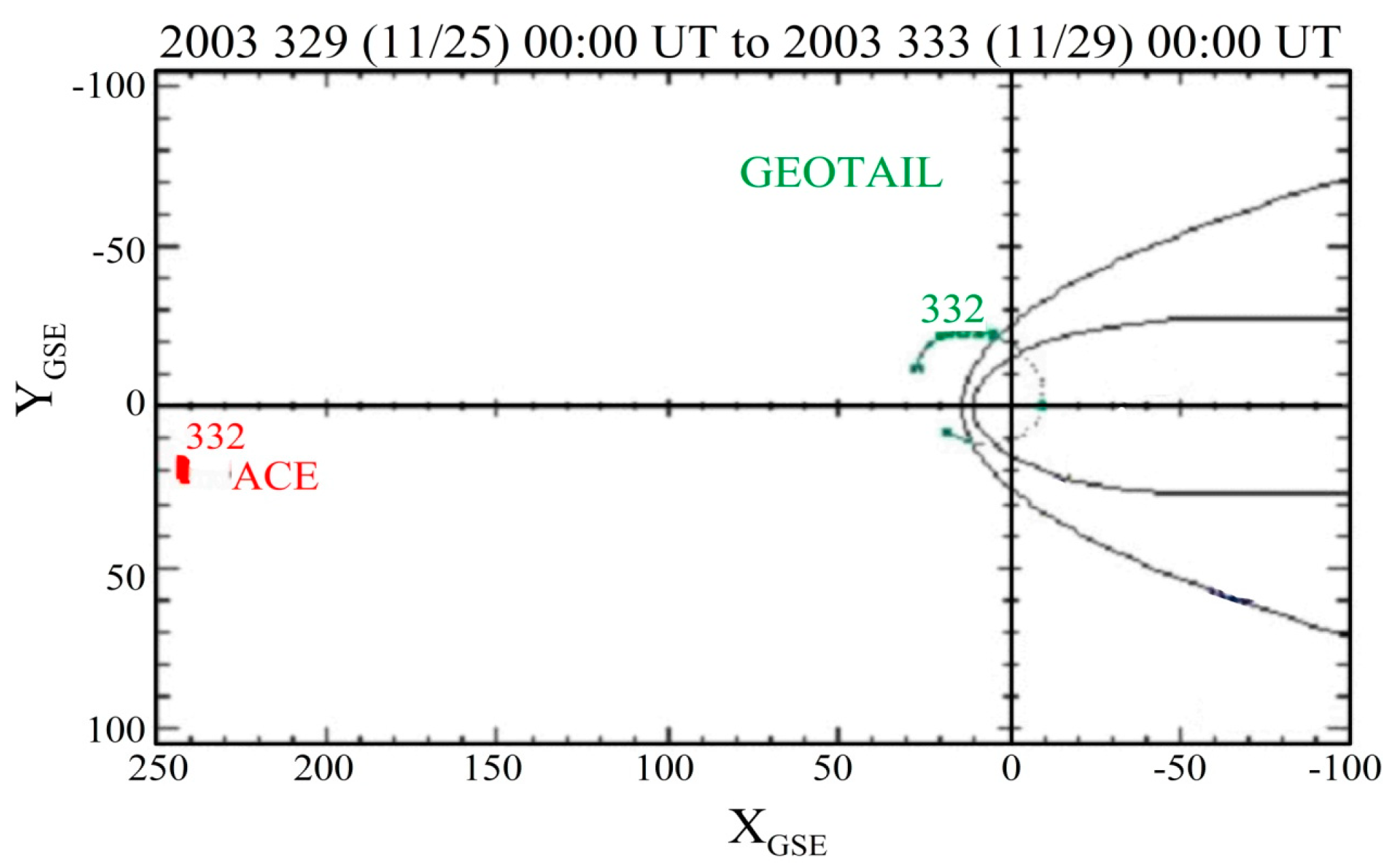
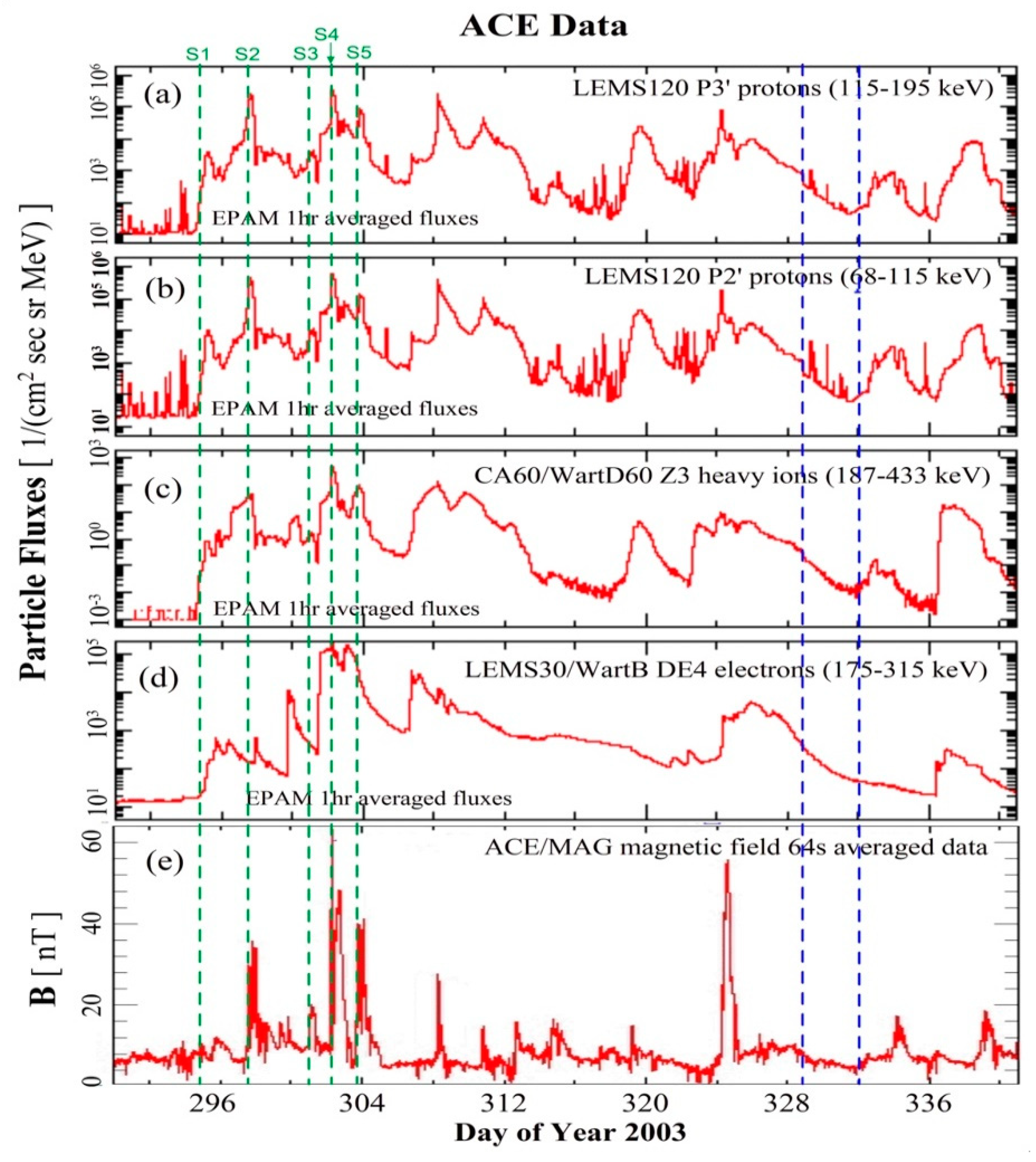
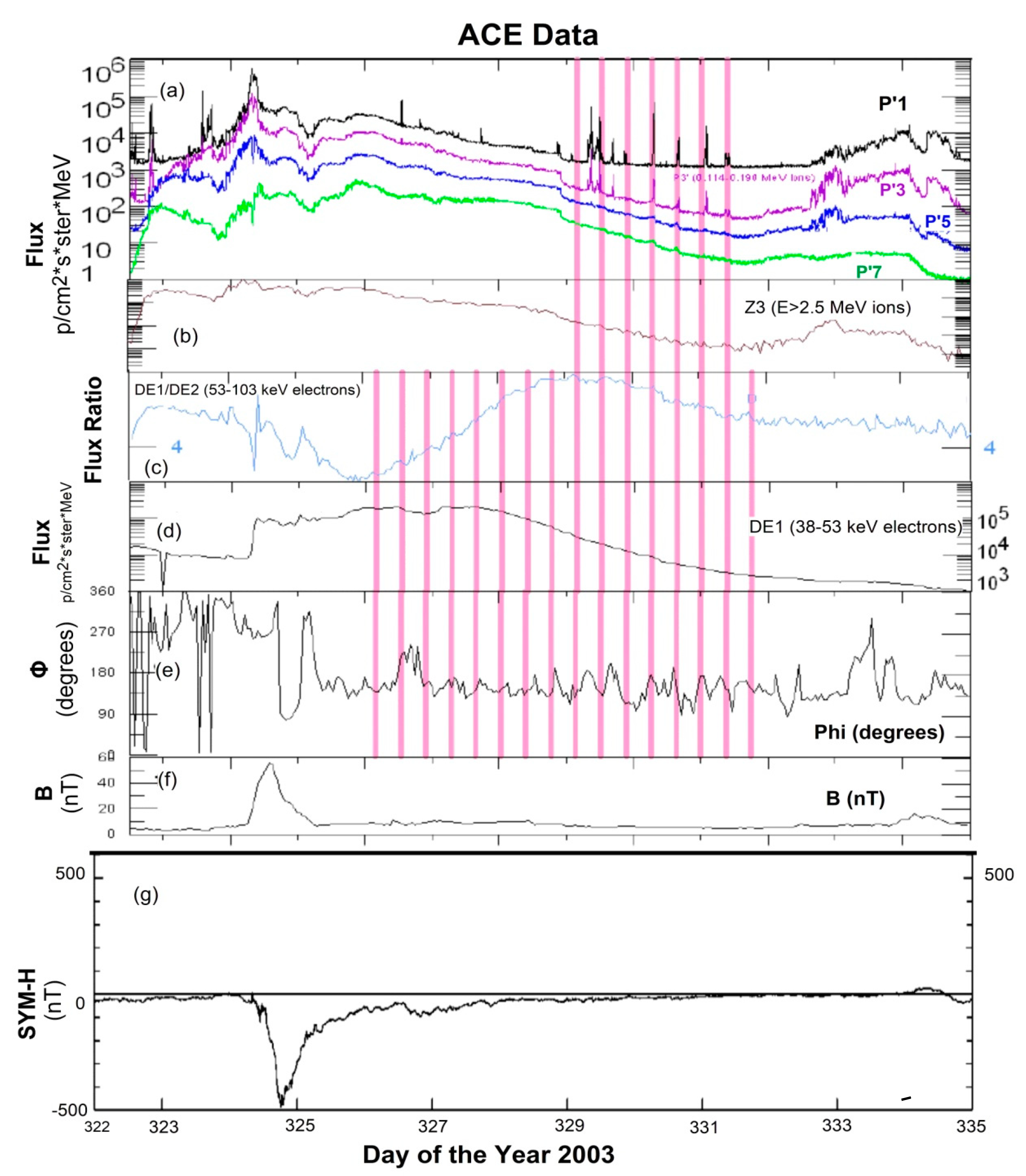
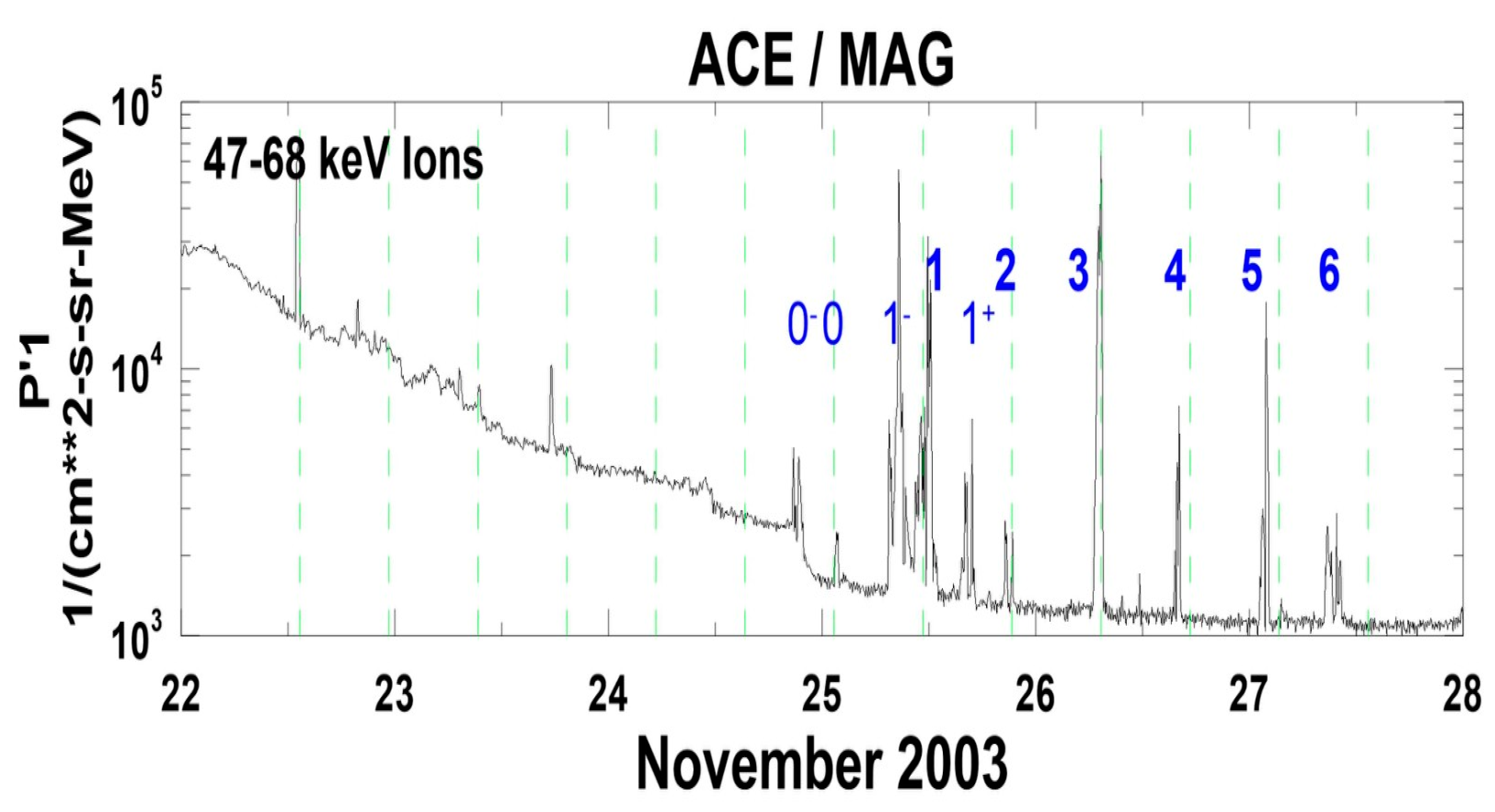

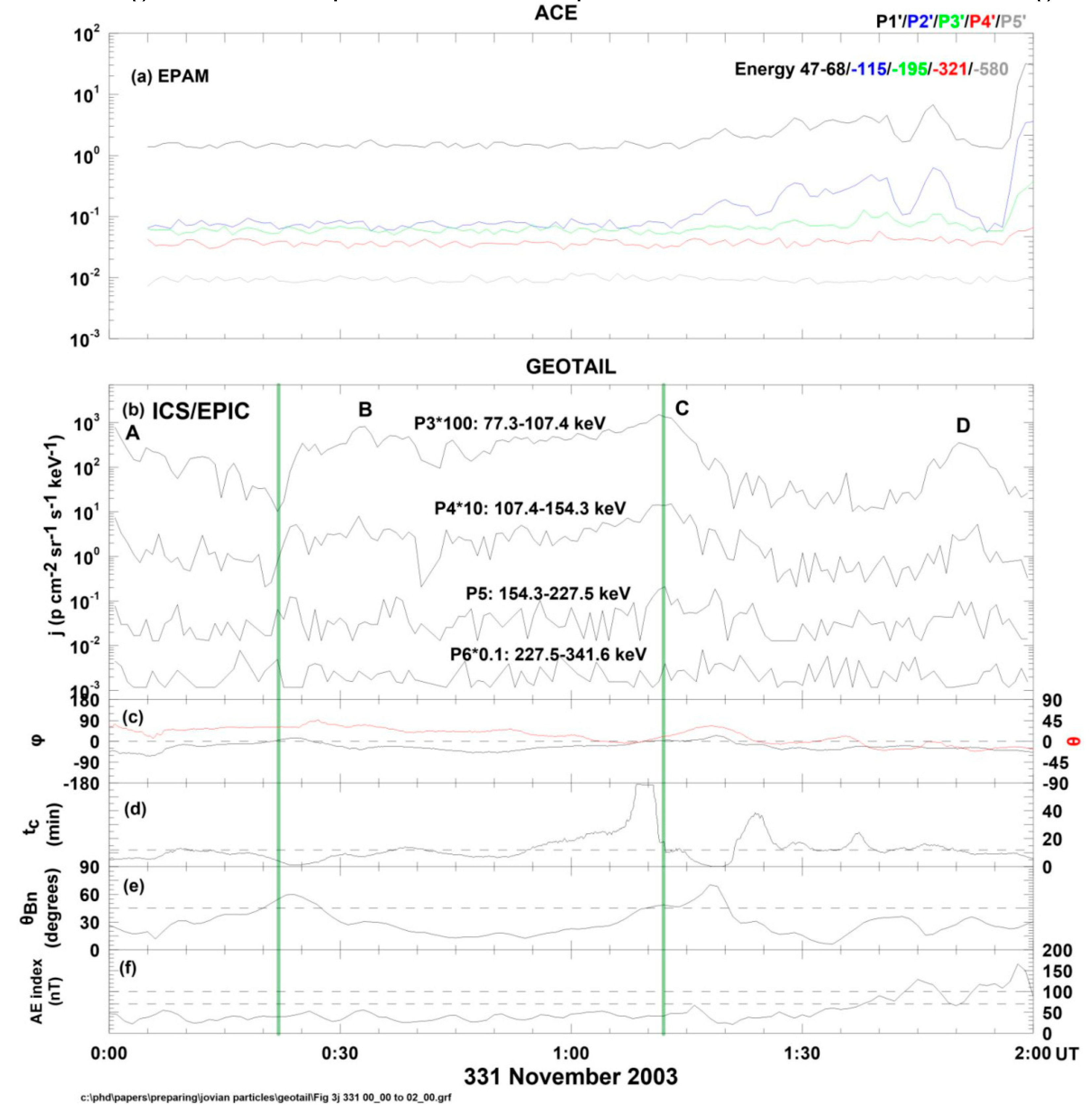
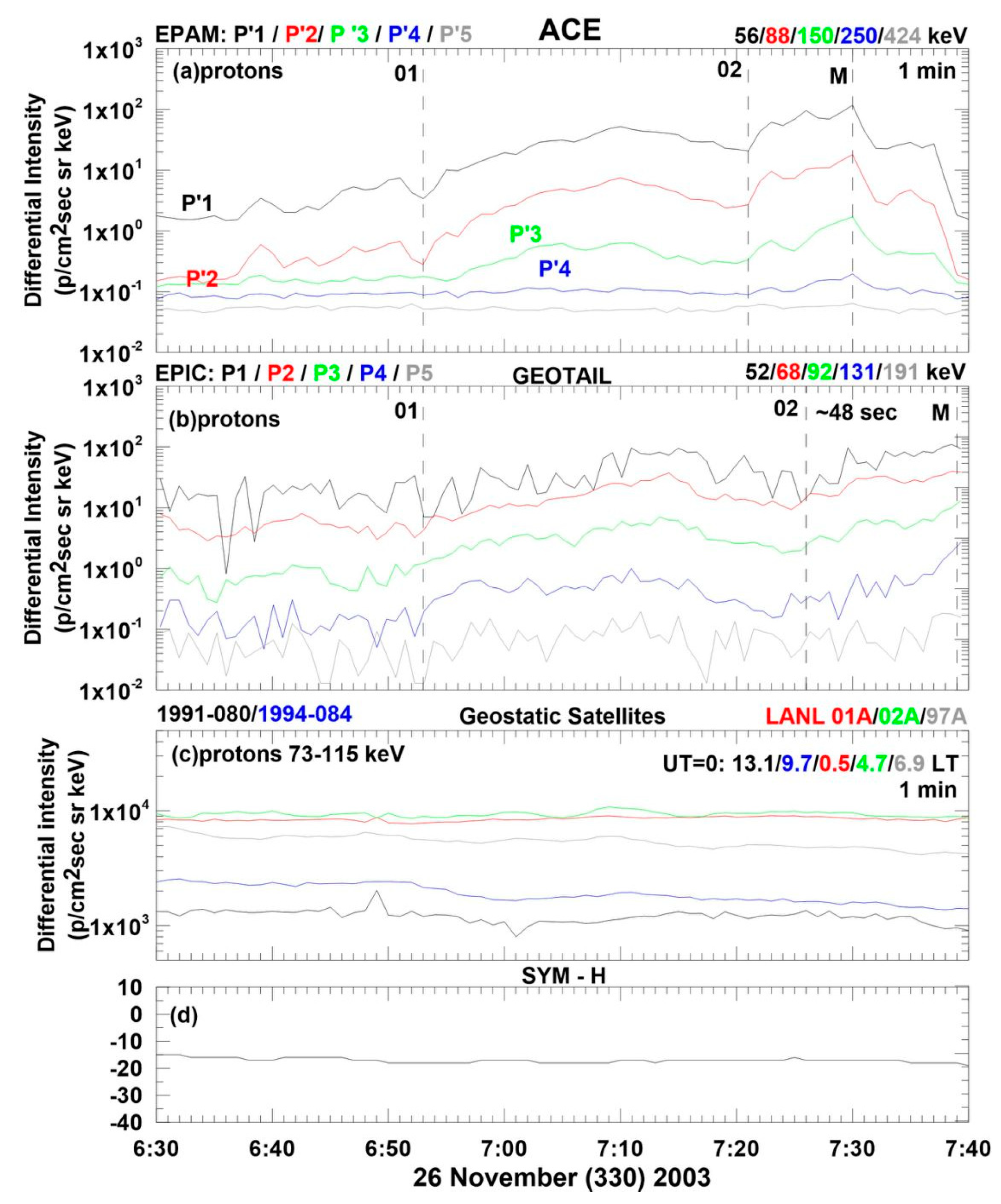
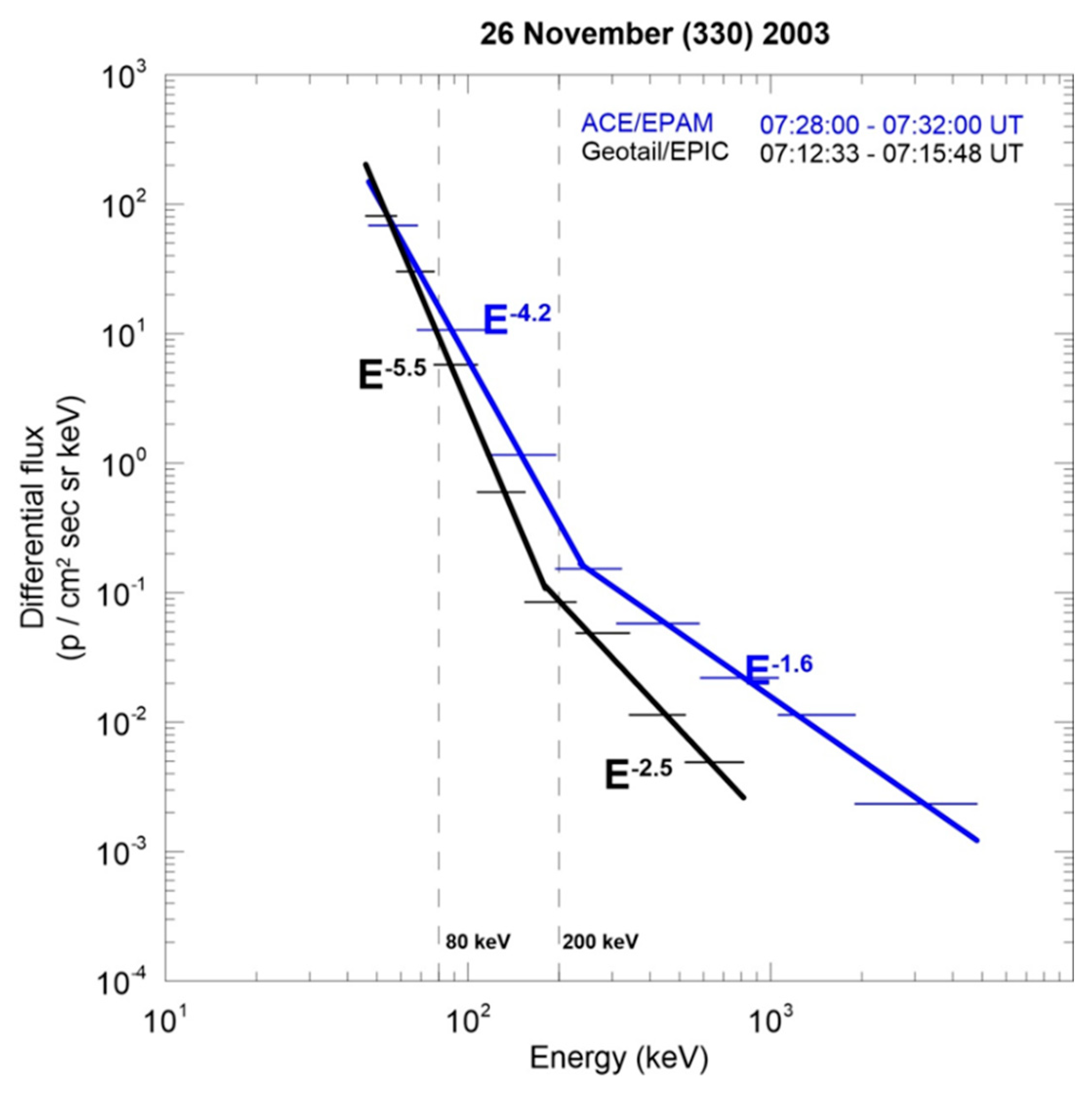

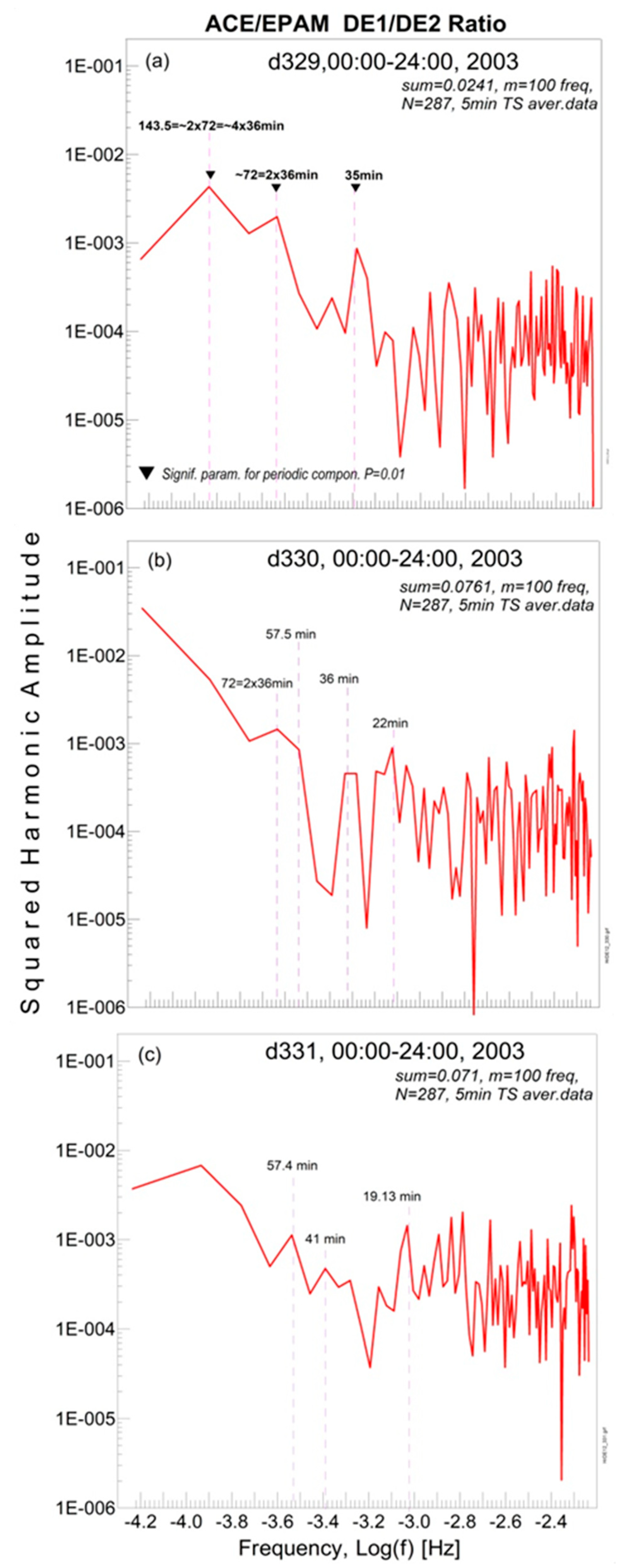
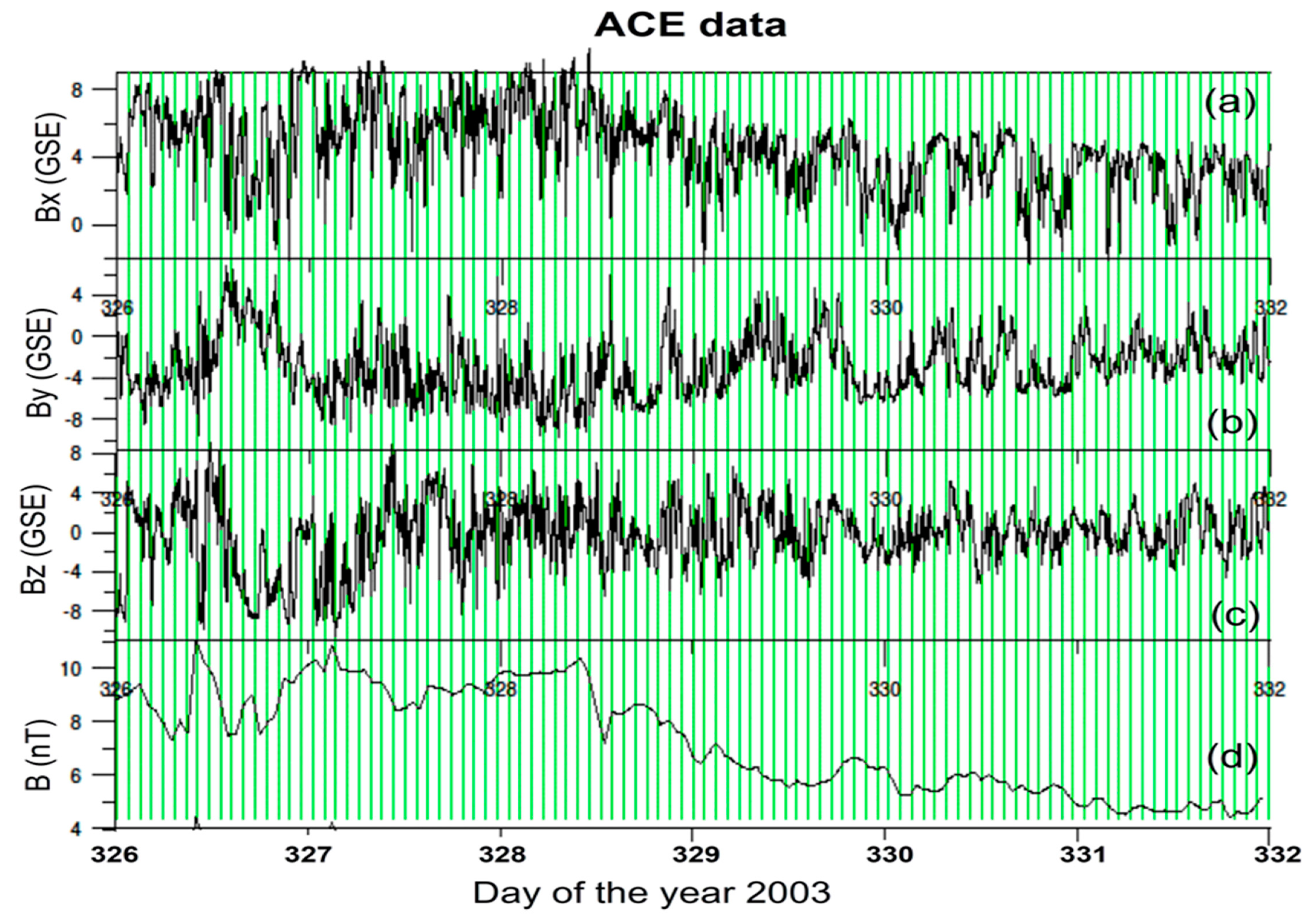
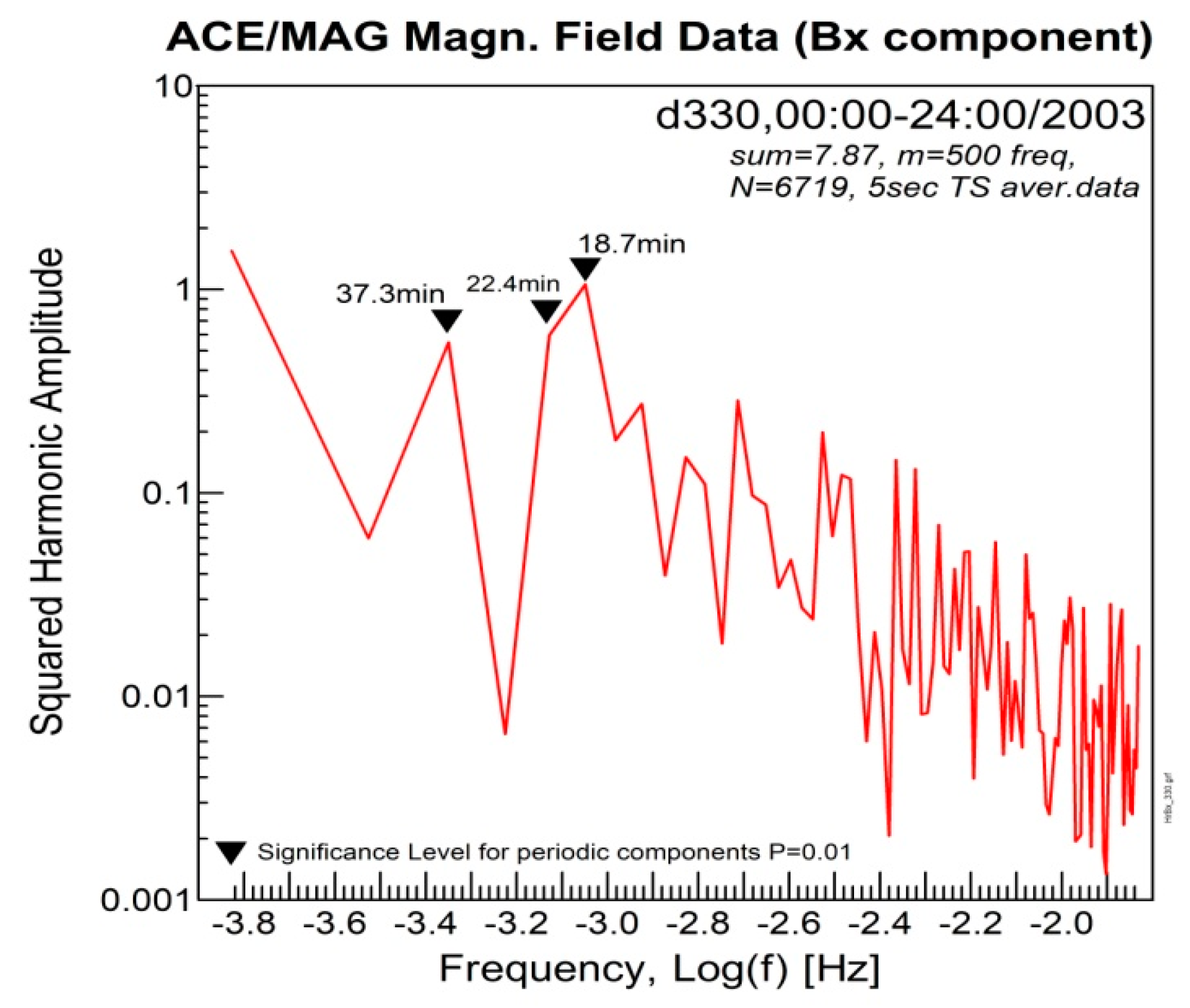
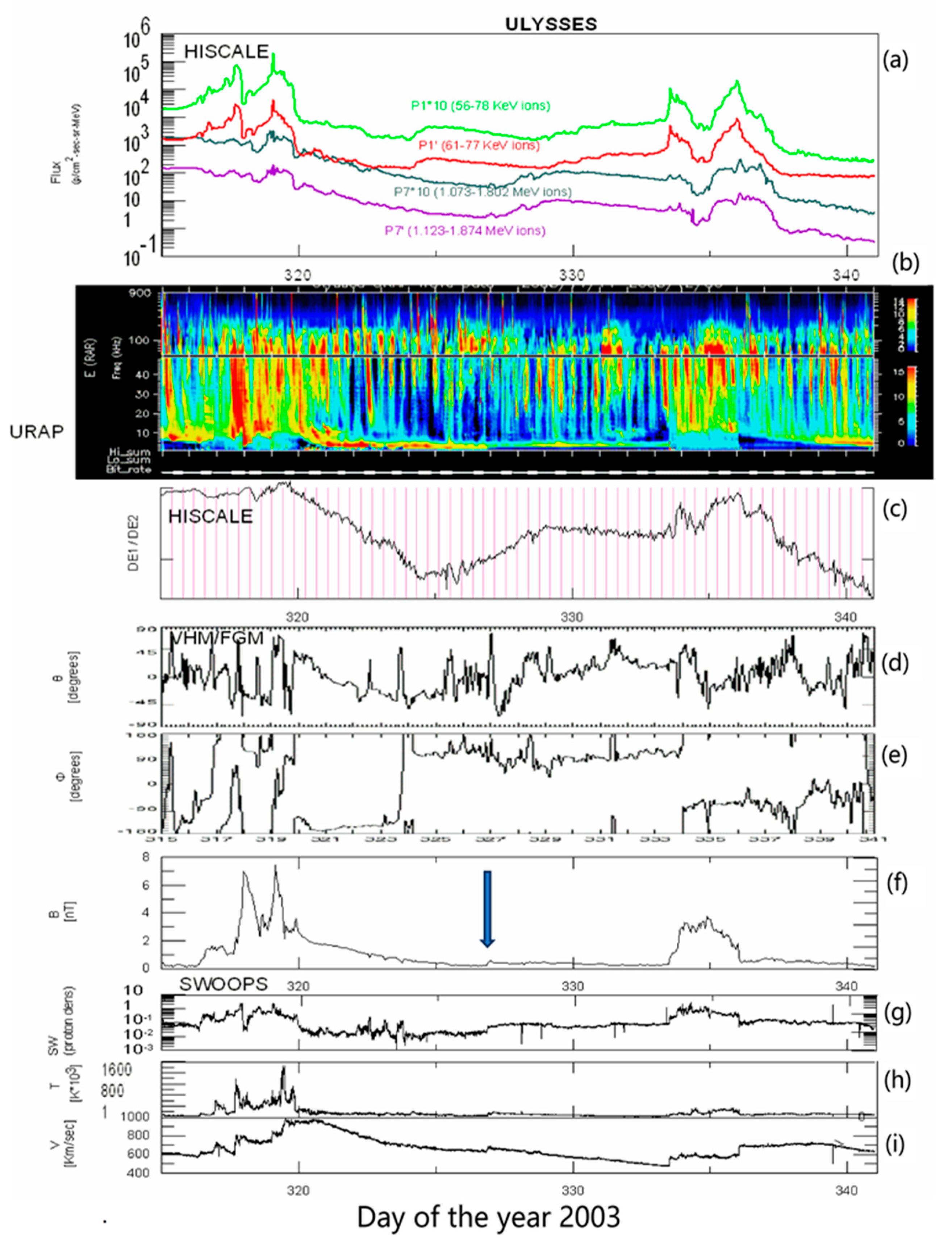
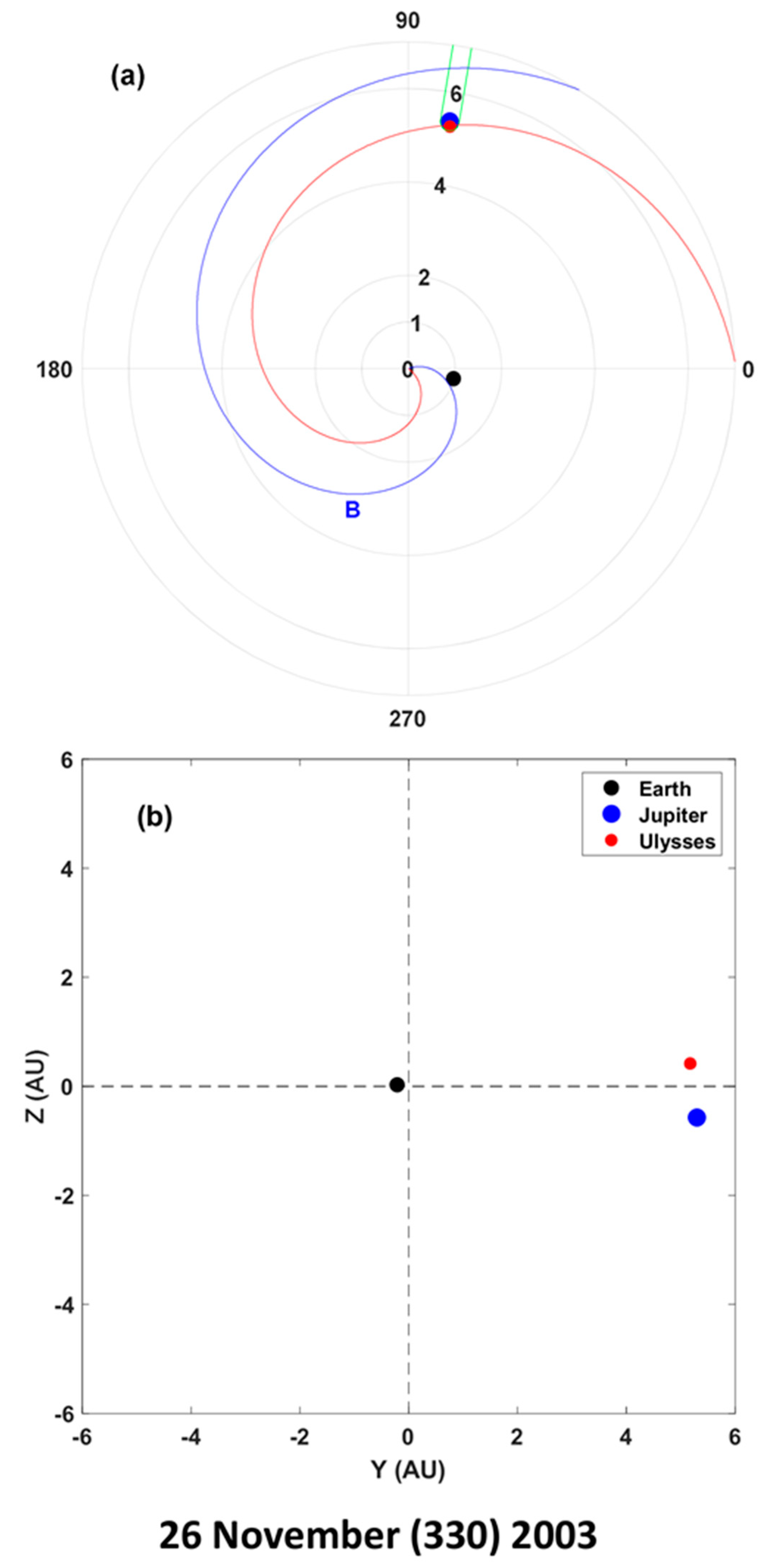
Disclaimer/Publisher’s Note: The statements, opinions and data contained in all publications are solely those of the individual author(s) and contributor(s) and not of MDPI and/or the editor(s). MDPI and/or the editor(s) disclaim responsibility for any injury to people or property resulting from any ideas, methods, instructions or products referred to in the content. |
© 2023 by the authors. Licensee MDPI, Basel, Switzerland. This article is an open access article distributed under the terms and conditions of the Creative Commons Attribution (CC BY) license (https://creativecommons.org/licenses/by/4.0/).
Share and Cite
Anagnostopoulos, G.C.; Marhavilas, P.K.; Vassiliadis, E.; Sarris, E.T. Jovian Periodicities (~10 h, ~40, 20, 15 min) at ACE, Upstream from the Earth’s Bow Shock, on 25–27 November 2003. Universe 2023, 9, 357. https://doi.org/10.3390/universe9080357
Anagnostopoulos GC, Marhavilas PK, Vassiliadis E, Sarris ET. Jovian Periodicities (~10 h, ~40, 20, 15 min) at ACE, Upstream from the Earth’s Bow Shock, on 25–27 November 2003. Universe. 2023; 9(8):357. https://doi.org/10.3390/universe9080357
Chicago/Turabian StyleAnagnostopoulos, Georgios C., Panagiotis K. Marhavilas, Efthymios Vassiliadis, and Emmanuel T. Sarris. 2023. "Jovian Periodicities (~10 h, ~40, 20, 15 min) at ACE, Upstream from the Earth’s Bow Shock, on 25–27 November 2003" Universe 9, no. 8: 357. https://doi.org/10.3390/universe9080357
APA StyleAnagnostopoulos, G. C., Marhavilas, P. K., Vassiliadis, E., & Sarris, E. T. (2023). Jovian Periodicities (~10 h, ~40, 20, 15 min) at ACE, Upstream from the Earth’s Bow Shock, on 25–27 November 2003. Universe, 9(8), 357. https://doi.org/10.3390/universe9080357






